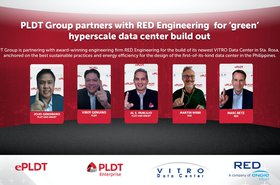The term ‘green data center’ has become synonymous with the industry’s shift to sustainability. But with greenwashing rife across the industry, what does it actually mean to be green?
“There are three key elements to look at when we talk about green data centers,” says Eric Lamendour, head of the Green Data Centers business platform at Engie.
According to Lamendour, a data center cannot be truly green if it is not consuming 24/7 carbon free energy (CFE). This can be achieved through a combination of grid supplied power (such as corporate power purchase agreements), onsite generation and renewable backup, as well as thermal and/or electrical energy storage.
Community support is also a key role of the green data center, achieved by integrating into the local energy ecosystem. In the same vein, these facilities can also support the grid thanks to capacity and ancillary services.
It’s also incredibly important that green ideas and expectations are established early in the data center lifecycle. When planning a green data center, its physical location is critical; how will it tie into greater planning across the neighborhood? How will it be connected to the grid?
Even the design of the data center has its caveats. “When you are trying to create a green data center, a large amount of the electrical, mechanical and structural systems need to be modified or designed differently, compared to a data center that might be borne from a historic design, or even a design from today,” says Martin Sieh, CEO, RED, an Engie Impact company.
“This encompasses the materials utilized, the magnitude of power generation you have onsite and the type of generation you have onsite. There are many aspects that are impacted during the design stage.
Sieh adds: “We also need to think about the additional concept of embedded carbon in the construction of the data center itself too. For example, the recycling of materials over their total lifespan.”
Evidently, achieving green status is no easy feat. It’s a commitment that traverses the entire data center lifecycle, from planning and design to construction and operation, all the way through to the lifespan of IT equipment.
The green rush
Fortunately – or unfortunately for those companies guilty of greenwashing – sustainability isn’t a passing trend and shouldn’t be treated as such.
As lovely as a “green wall” on a facility somewhere might be, in isolation it makes little impact on the real matter at hand: the need for decarbonization, and data centers have a key part to play.
“Green data centers and the data center vertical market as a whole, are critical to the future of overall decarbonization and sustainability because of the sheer amount of compute power that will be required in the future,” explains Sieh.
Everything we do is becoming increasingly digitized, not only at speed but at scale. Take the rapid expansion of data with regards to autonomous vehicles for instance. Or the fact many of us spend inordinate amounts of time scrolling social media, or streaming content on platforms like Netflix. As recently as ten years ago, these seemingly ‘normal’ activities just didn’t exist.
And the metaverse will continue to shape our universe. Advances in online gaming, virtual reality, augmented reality, and artificial intelligence, means the compute power required to transact and provide the infrastructure to support new technology will only continue to pick up speed, ultimately forming the foundation of energy consumption across the world.
One size does not fit all
You can look to decarbonize a facility, on an annual basis, via the use of corporate PPAs. But, of course, renewable energy comes with its own challenges. Wind and solar energy for example are intermittent and won’t provide 100 percent carbon-free energy 100 percent of the time.
Therefore, to achieve the full green package and switch from an annual basis to an hourly renewable energy matching, you need to add on-site renewable energy generation into the mix, as well as green backup and energy storage. But what happens when this just isn’t an option?
As a global company, Engie understands that different geographies require different solutions. Referring to the state of play in Singapore, one of the most technologically advanced ICT markets in the world, Wandrille Doucerain, head of Business Development for data center solutions at Engie Southeast Asia, highlights some of the challenges.
“The way we look at it here, there is a clear conundrum between more data and more sustainability,” says Doucerain. “Energy is rare in Singapore and roughly 12 percent of the actual power consumption of the country is taken up by data centers, it’s absolutely huge.”
But when the potential for green power and space is limited, you need to find new solutions. “We are seeing a lot of R&D in liquid immersion cooling and we’re seeing a big push from authorities to implement building constraints, which ensure new data center facilities are built to be as highly efficient and sustainable as possible.”
In addition to liquid cooling, Singapore is also looking at importing ‘green H2’ from neighboring countries such as Malaysia and Indonesia.
This serves to highlight that if you have the expertise, no problem is without a solution. And no matter where a data center is located, with the right green solutions, the whole sector has the power to move the needle itself – if – we act now.
“If we focus and work hard to create green data centers now, we can change the overall curve and the overall outcomes 10-15 years from now. That's why data centers are such an important aspect of the overall macro decarbonization of, really, the overall energy system and us as a society,” says Sieh.
From burden to benefit
Although historically, ‘green’ wasn’t exactly a word synonymous with the data center, in recent years they have become increasingly useful drivers when it comes to the decarbonization of the energy grid, as well as decarbonizing their own assets via heat reuse and those of the communities they’re in through innovative district cooling and heating projects.
“We want to help the data center industry become a benefit not a burden, it’s as simple as that,” affirms Lamendour.
Not only can data centers help decarbonize the grid, but stabilize it too. “It’d be wonderful to have 100 percent green data centers, but as a basis you have to have incredibly reliable grids, otherwise the ‘green’ you create is very unstable,” says Doucerain. “This has been the case in Vietnam, with a massive input of green power, not just for data center use, but it has created a lot of imbalances on the grid.”
This is where data centers become part of the solution, with grid operators able to place data center clusters in strategic places to help balance things out. This is particularly useful in countries where the grid alone isn’t stable enough to handle growing demand.
From a community perspective, by providing the right compute power in the right places, these facilities can quite literally grow an economy, acting as an asset to not only help create jobs, but draw in investment opportunities that otherwise would not have existed.
Data centers are no longer the menaces to society they were once (unfairly) seen to be, and in many geographies, are very much a part of the sustainability solution.
Decarbonization is a huge piece of the sustainability puzzle and won’t be achieved through one solution alone, or by one company. And despite data centers attempting to differentiate from their competitors through advanced sustainability programs, collaboration is needed to reach true sustainability.
If we want to see that needle move, we must remember that achieving sustainability is a global goal that requires a global effort. We need trusted partners the likes of Engie, who via the integration of green strategy, technology, and knowledge, can enable the highly available green energy and green attitudes data centers need to be a driving force for decarbonization.
More from Engie
-

Sponsored PLDT Group partners with RED Engineering for green hyperscale data center build out
The PLDT Group has partnered with award-winning engineering firm RED Engineering for the build of its newest VITRO data center in Sta. Rosa, Laguna
-

Sponsored Will decarbonization impact future data center design?
A closer look at the prosumer approach, with Eric Lamendour of Engie
-

Orange partners with Engie to install solar panels at Ivory Coast data center
Engie to install more than 780 panels on 179,000 sq ft facility

